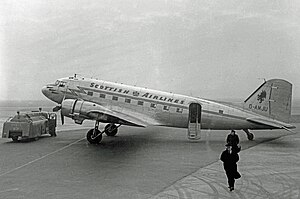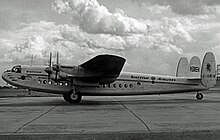Scottish Airlines
| Scottish Airlines | |
|---|---|
 Douglas DC-3 / C-47B of Scottish Airlines, Manchester 1952 |
|
| IATA code : | (without) |
| ICAO code : | (unknown) |
| Call sign : | (unknown) |
| Founding: | 1946 |
| Operation stopped: | 1961 |
| Seat: | Prestwick Airport |
| Turnstile : | |
| Home airport : | Prestwick Airport |
| Fleet size: | 3 |
| Aims: | Domestic, Europe, intercontinental |
| Scottish Airlines ceased operations in 1961. The information in italics refer to the last status before the end of operation. | |
Scottish Airlines was a British airline with seat on the Prestwick Airport .
history
Scottish Airlines was founded in 1946 as a subsidiary of the aircraft manufacturer Scottish Aviation . The first scheduled service was flown on January 28, 1946 on behalf of British European Airways (BEA) with a Douglas DC-3 between Prestwick and Belfast. On May 27 of the same year, Icelandair began a two-year contract to set up a liner service between Prestwick, Copenhagen and Reykjavik with DC-3 and Consolidated Liberator II . The acquisition of minority stakes in Luxembourg Airlines and the Greek Hellenic Airlines made it possible to obtain similar orders.
At the end of 1950 the Consolidated Liberators were taken out of the fleet, resulting in a lack of capacity in heavy transport aircraft. Only at the end of 1952 could this gap be closed by the acquisition of three Avro Yorks from the stocks of the Royal Air Force , which were expanded to a fleet of 8 copies over the course of the next three years.
After five Avro Yorks were lost in troop transport flights on behalf of the British Department of Defense, these orders were discontinued. This contributed to the decline of society. In November 1960 the flight operations were stopped, then the company was dissolved. In 1961, the aircraft and route rights were then taken over by Dan-Air . The parent company, the aircraft manufacturer Scottish Aviation, was integrated into British Aerospace in 1977 . The Prestwick plant closed in 1998.
Destinations
In addition to a few smaller domestic scheduled flights, the company also operated worldwide charter flights, both as cargo and as passenger flights.
From August 1948, Scottish Airlines began supply flights from Schleswig Air Base and from Wunstorf RAF Station ( Lower Saxony ) to Berlin-Gatow Airfield with three Consolidated Liberator II and two Douglas DC-3s and thus also took part in the Berlin Airlift .
The route from Prestwick to the Isle of Man , which was flown regularly in summer, proved to be very lucrative . In 1953 alone, almost 15,000 passengers could be carried here.
At times, scheduled flights were also undertaken on behalf of KLM, BEA and Air France. A large share of the business was made up of troop transport flights on behalf of the British Ministry of Defense, which in addition to Malta were also carried out to Montreal, Cyprus and the Egyptian Canal Zone.
fleet
Fleet at the end of operations
Previously deployed aircraft
The following types of aircraft were also used before:
- Airspeed Oxford
- Avro York
- Consolidated LB-30 Liberator II Transport
- De Havilland DH.89 Dragon Rapide
- Percival Proctor
Incidents
From the founding in 1946 to the cessation of operations in 1960, Scottish Airlines suffered 9 total aircraft losses. 64 people were killed in 5 of them. Full list:
- On October 13, 1948, a Consolidated Liberator II of Scottish Airlines ( aircraft registration G-AHZP ) was approached too low at Liverpool-Speke Airport (Great Britain) and grazed street lights outside the airport. The aircraft was irreparably damaged in the subsequent crash landing. All 4 crew members of the cargo flight survived.
- On 13 April 1954 an unsuccessful Avro York C.1 Scottish Airlines (G-Amum) on the Malta-Luqa airport . The starter of one of the engines was defective. That is why the captain came up with the glorious idea of starting this engine by accelerating the propeller when rolling with the airstream. This actually succeeded, but only so shortly before the end of the runway that it quickly rolled over and the aircraft was irreparably damaged. All 3 crew members survived the mishap.
- On September 22, 1954, an Avro York C.1 of Scottish Airlines (G-ANRC) drifted to the left during crosswind take-off at Stansted Airport ( Great Britain ); it was over-corrected and the machine swung to the right, collapsing the landing gear. A fire broke out and destroyed the aircraft. All 49 occupants, 5 crew members and 44 passengers survived.
- On February 18, 1956, the York with the registration number G-ANSY of Scottish Airlines crashed shortly after taking off from Malta Airport after an engine failure. All 50 people on board were killed.
- On April 30, 1956, an Avro York C.1 of Scottish Airlines (G-AMUL) taking off for Malta got off the runway when the takeoff was aborted at Stansted Airport (Great Britain) and crossed a ditch, causing the landing gear to collapse. Of the 54 occupants, 2 passengers were killed; all 5 crew members and 47 passengers survived. The aircraft was damaged beyond repair.
- On December 7, 1957, a Scottish Aviation Twin Pioneer 1 of Scottish Airlines (G-AOEO) crashed in the desert, 460 kilometers south-southwest of Tripoli, on its return flight to Tripoli Idris International Airport ( Libya ). The cause of the accident was determined to be a fatigue fracture in a strut on the left wing; the plane was only 15 months old. All 6 occupants, 2 crew members and 4 passengers, were killed.
- On December 23, 1957, an Avro York C.1 of Scottish Airlines (G-AMUN) coming from Malta collided with a tree 1200 meters from the runway during the third approach to London-Stansted Airport (Great Britain), crashed and caught fire. All 4 crew members were killed.
- On December 12, 1959, a Scottish Aviation Twin Pioneer 3 of Scottish Airlines (G-AOEN) near Luabo ( Mozambique ) was totaled . The left engine was switched off on a demonstration flight. When the aircraft lost altitude even with the right engine at maximum power, attempts were made in vain to get the left engine running again. During the emergency landing on an island in the Zambezi , both wings and the landing gear broke off. All 15 occupants, 1 pilot and 14 passengers survived.
- On March 10, 1960, the left engine of a Scottish Aviation Twin Pioneer 3 of Scottish Airlines (G-ANTP) failed at a height of about 10 meters when taking off from Jorhat-Rowriah Airport ( India ). The flow stalled . The plane crashed and caught fire. Of the 3 crew members, 2 were killed.
See also
literature
- Arthur Pearcy: Berlin Airlift. Airlife Publications, Shrewsbury 1997, ISBN 1-85310-845-6 .
- Maurice J. Wickstead: Airlines of the British Isles since 1919 . Air-Britain (Historians), Staplefield, W Sussex 2014, ISBN 978-0-85130-456-4 .
Web links
Individual evidence
- ↑ Wickstead 2014, p. 370.
- ↑ Wickstead 2014 S. 371st
- ^ Pearcy 1997.
- ^ Tony Eastwood, John Roach: Piston Engine Airliner Production List. The Aviation Hobby Shop, West Drayton 1996, ISBN 0-907178-61-8 .
- ↑ Accident statistics Scottish Airlines , Aviation Safety Network (English), accessed on October 27, 2019.
- ↑ Accident Report Liberator G-AHZP , Aviation Safety Network (English), accessed on 27 October of 2019.
- ^ Accident report Avro York G-AMUM , Aviation Safety Network (English), accessed on October 27, 2019.
- ^ Accident report Avro York G-ANRC , Aviation Safety Network (English), accessed on October 27, 2019.
- ^ Accident report Avro York G-ANSY , Aviation Safety Network (English), accessed on January 19, 2016.
- ^ Accident report Avro York G-AMUL , Aviation Safety Network (English), accessed on October 27, 2019.
- ^ ICAO Aircraft Accident Digest 9, Circular 56-AN / 51, Montreal 1959 (English), pp. 241-244.
- ↑ Accident report Twin Pioneer G-AOEO , Aviation Safety Network (English), accessed on October 27, 2019.
- ^ Accident report Avro York G-AMUN , Aviation Safety Network (English), accessed on October 27, 2019.
- ↑ Accident report Twin Pioneer G-AOEN , Aviation Safety Network (English), accessed on October 27, 2019.
- ↑ Accident report Twin Pioneer G-ANTP , Aviation Safety Network (English), accessed on October 27, 2019.
